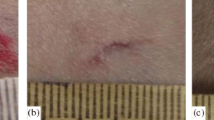Abstract
Healing of full-thickness skin wounds was studied in carnivores: cats, foxes, and arctic foxes. Square wounds, initially measuring on average 2.2 cm2, were inflicted on the back and head of the cats and on the thigh of the foxes and arctic foxes. Closure of the skin defect in all species of animals was found to take place mainly through contraction of the wound. The small focus of regeneration formed in the center of the initial defect closely resembled in many of its features the structure of normal skin: it contained hairs and sebaceous glands, and its connective-tissue basis resembled dermis in the arrangement of its fibers.
Similar content being viewed by others
Literature Cited
M. E. Aspiz, in: Problems in Regeneration of Organs and Tissues of Vertebrates [in Russian], Moscow (1954), pp. 92–113.
A. A. Braun, Izvest. Akad. Nauk SSSR. Seriya Biol., No. 6, 695 (1945).
E. A. Efimov, Posttraumatic Regeneration of the Skin [in Russian], Moscow (1975).
I. Ya. Kamenetskii, in: Proceedings of the 2nd Scientific Conference of Morphologists of Central Asia and Kazakhstan [in Russian], Dushanbe (1968), pp. 90–92.
A. A. Khanin, Zh. Éksper. i Klin. Med., No. 14, 13 (1969).
J. Joseph and F. J. Townsend, Brit. J. Surg.,48, 557 (1961).
Rights and permissions
About this article
Cite this article
Efimov, E.A. Completeness of regeneration of the skin. Bull Exp Biol Med 81, 442–444 (1976). https://doi.org/10.1007/BF00804944
Received:
Issue Date:
DOI: https://doi.org/10.1007/BF00804944




